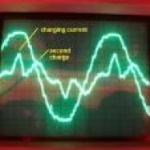Multivibrator Circuit
Page 1 of 1
 Multivibrator Circuit
Multivibrator Circuit
A multivibrator is an electronic circuit used to implement a variety of simple two-state systems such as oscillators, timers and flip-flops. It is characterized by two amplifying devices (transistors, electron tubes or other devices) cross-coupled by resistors and capacitors.
There are three types of multivibrator circuit:
1. Astable, in which the circuit is not stable in either state—it continuously oscillates from one state to the other.

This circuit diagram shows how a 555 timer IC is configured to function as an astable multivibrator. An astable multivibrator is a timing circuit whose 'low' and 'high' states are both unstable. As such, the output of an astable multivibrator toggles between 'low' and 'high' continuously, in effect generating a train of pulses. This circuit is therefore also known as a 'pulse generator' circuit.
In this circuit, capacitor C1 charges through R1 and R2, eventually building up enough voltage to trigger an internal comparator to toggle the output flip-flop. Once toggled, the flip-flop discharges C1 through R2 into pin 7, which is the discharge pin. When C1's voltage becomes low enough, another internal comparator is triggered to toggle the output flip-flop. This once again allows C1 to charge up through R1 and R2 and the cycle starts all over again.
C1's charge-up time t1 is given by: t1 = 0.693(R1+R2)C1. C1's discharge time t2 is given by: t2 = 0.693(R2)C1. Thus, the total period of one cycle is t1+t2 = 0.693 C1(R1+2R2). The frequency f of the output wave is the reciprocal of this period, and is therefore given by:
f = 1.44/(C1(R1+2R2)), wherein f is in Hz if R1 and R2 are in megaohms and C1 is in microfarads.
2. Monostable, in which one of the states is stable, but the other is not—the circuit will flip into the unstable state for a determined period, but will eventually return to the stable state. Such a circuit is useful for creating a timing period of fixed duration in response to some external event. This circuit is also known as a one shot. A common application is in eliminating switch bounce.
The waveforms in figure 1 illustrate the operation of a monostable. A monostable circuit produces one pulse of a set length (time period T) in response to a trigger input such as a push button. The output of the circuit stays in the low state until there is a trigger input, hence the name "monostable" meaning "one stable state". This type of circuit is ideal for use in a "push to operate" system for a model displayed at exhibitions. A visitor can push a button to start a model's mechanism moving, and the mechanism will automatically switch off after a set time. Another use for the circuit is to 'de-bounce' a push button input to a digital IC

The 555 Monostable Circuit
The circuit diagram of the 555 monostable circuit is given in figure 2. Notice that the resistor value R and the capacitor value C are unspecified. The values of these components determine the length of time that the monostable output is in the high state, and they may be calculated using the equation below...
T=1.1RC
...where T is the time period in seconds, and R and C are the component values in Ohms (Ω) and Farads (F).

Doing the Calculations
Here is a step-by-step guide to calculating the value of resistor R - an example is given in curly braces {}.

If the resistor value you calculated is smaller than 1kΩ or larger than 1MΩ, you should re-do the calculation with a different value for capacitor C until
you get a resistor value within the acceptable range.
Varying the Time Period
If you will need to adjust the time period of the monostable circuit in use, you can use a linear variable resistor for R, as shown in figure 3.
Because the resistance of a variable resistor goes down to around 0Ω at one end of its range, a 1kΩ resistor is placed in series with it so that the value of R will never fall below 1kΩ. As the shaft of the
variable resistor is turned from its lowest setting to its highest, T
will become longer.
If your chosen variable resistor has three connections, it is a potentiometer, and you should connect to the centre connection and either of the end connections.
The Trigger Input
As you can see from figure 1, the 555's Trigger input must be taken low to trigger the monostable. This is achieved in figure 2 by placing a button in series with a resistor across the power supply. Normally, the 10kΩ
resistor keeps the Trigger input high, at the voltage Vs, and the monostable is
in its steady state. When the button is pushed, the Trigger input is
directly connected to 0V and the time period T starts.
The Reset Input
If you want to make the monostable output go low before the time period has elapsed, simply take the 555's Reset input briefly low. This can be achieved with a push button in exactly the same way as with the Trigger input.
De-bouncing
When a push button is pressed or released, the contacts will bounce between the on and off states for a fraction of a second. If the button is connected to the input of a digital IC, then the IC will think the button is being pressed several times rather than once. While this may not matter in some circuits like the monostable, to others it will produce erratic behaviour.
For example, if the button is connected to the Clock input of a digital counter IC, the counter output should increment once every time the button is pressed. Instead it will count perhaps 5 times due to the contact bounce in the button.
To solve the problem, the push button must be 'de-bounced' by placing a small delay between it and the digital input - an ideal application for a monostable. Figure 4 shows a block diagram of this arrangement. Obviously, there is a need to get the length of the delay (the time period) correct - too short and some of the bounce will get through, too long and you will prevent quick successions of button presses having an effect on the digital input. A suitable time period for most applications would be around 100ms. To make a 555 monostable with this time period you would need to make R = 91kΩ and C = 1μF.

3. Bistable, in which the circuit will remain in either state indefinitely. The circuit can be flipped from one state to the other by an external event or trigger. Such a circuit is important as the fundamental building block of a register or memory device. This circuit is also known as a flip-flop.
There are three types of multivibrator circuit:
1. Astable, in which the circuit is not stable in either state—it continuously oscillates from one state to the other.

This circuit diagram shows how a 555 timer IC is configured to function as an astable multivibrator. An astable multivibrator is a timing circuit whose 'low' and 'high' states are both unstable. As such, the output of an astable multivibrator toggles between 'low' and 'high' continuously, in effect generating a train of pulses. This circuit is therefore also known as a 'pulse generator' circuit.
In this circuit, capacitor C1 charges through R1 and R2, eventually building up enough voltage to trigger an internal comparator to toggle the output flip-flop. Once toggled, the flip-flop discharges C1 through R2 into pin 7, which is the discharge pin. When C1's voltage becomes low enough, another internal comparator is triggered to toggle the output flip-flop. This once again allows C1 to charge up through R1 and R2 and the cycle starts all over again.
C1's charge-up time t1 is given by: t1 = 0.693(R1+R2)C1. C1's discharge time t2 is given by: t2 = 0.693(R2)C1. Thus, the total period of one cycle is t1+t2 = 0.693 C1(R1+2R2). The frequency f of the output wave is the reciprocal of this period, and is therefore given by:
f = 1.44/(C1(R1+2R2)), wherein f is in Hz if R1 and R2 are in megaohms and C1 is in microfarads.
2. Monostable, in which one of the states is stable, but the other is not—the circuit will flip into the unstable state for a determined period, but will eventually return to the stable state. Such a circuit is useful for creating a timing period of fixed duration in response to some external event. This circuit is also known as a one shot. A common application is in eliminating switch bounce.
The waveforms in figure 1 illustrate the operation of a monostable. A monostable circuit produces one pulse of a set length (time period T) in response to a trigger input such as a push button. The output of the circuit stays in the low state until there is a trigger input, hence the name "monostable" meaning "one stable state". This type of circuit is ideal for use in a "push to operate" system for a model displayed at exhibitions. A visitor can push a button to start a model's mechanism moving, and the mechanism will automatically switch off after a set time. Another use for the circuit is to 'de-bounce' a push button input to a digital IC

The 555 Monostable Circuit
The circuit diagram of the 555 monostable circuit is given in figure 2. Notice that the resistor value R and the capacitor value C are unspecified. The values of these components determine the length of time that the monostable output is in the high state, and they may be calculated using the equation below...
T=1.1RC
...where T is the time period in seconds, and R and C are the component values in Ohms (Ω) and Farads (F).

Doing the Calculations
Here is a step-by-step guide to calculating the value of resistor R - an example is given in curly braces {}.
- Firstly, decide the time period T that you require. This can be very small (milliseconds) or large (minutes), but it must be expressed in seconds. {I choose T = 10 seconds}
- Next, guess a value for the capacitor C, expressed in Farads. For starters, try 100μF. {I choose C = 100μF}
- Put the values of T and C into the equation below and calculator resistor R...

If the resistor value you calculated is smaller than 1kΩ or larger than 1MΩ, you should re-do the calculation with a different value for capacitor C until
you get a resistor value within the acceptable range.
Varying the Time Period
If you will need to adjust the time period of the monostable circuit in use, you can use a linear variable resistor for R, as shown in figure 3.
Because the resistance of a variable resistor goes down to around 0Ω at one end of its range, a 1kΩ resistor is placed in series with it so that the value of R will never fall below 1kΩ. As the shaft of the
variable resistor is turned from its lowest setting to its highest, T
will become longer.
If your chosen variable resistor has three connections, it is a potentiometer, and you should connect to the centre connection and either of the end connections.
The Trigger Input
As you can see from figure 1, the 555's Trigger input must be taken low to trigger the monostable. This is achieved in figure 2 by placing a button in series with a resistor across the power supply. Normally, the 10kΩ
resistor keeps the Trigger input high, at the voltage Vs, and the monostable is
in its steady state. When the button is pushed, the Trigger input is
directly connected to 0V and the time period T starts.
The Reset Input
If you want to make the monostable output go low before the time period has elapsed, simply take the 555's Reset input briefly low. This can be achieved with a push button in exactly the same way as with the Trigger input.
De-bouncing
When a push button is pressed or released, the contacts will bounce between the on and off states for a fraction of a second. If the button is connected to the input of a digital IC, then the IC will think the button is being pressed several times rather than once. While this may not matter in some circuits like the monostable, to others it will produce erratic behaviour.
For example, if the button is connected to the Clock input of a digital counter IC, the counter output should increment once every time the button is pressed. Instead it will count perhaps 5 times due to the contact bounce in the button.
To solve the problem, the push button must be 'de-bounced' by placing a small delay between it and the digital input - an ideal application for a monostable. Figure 4 shows a block diagram of this arrangement. Obviously, there is a need to get the length of the delay (the time period) correct - too short and some of the bounce will get through, too long and you will prevent quick successions of button presses having an effect on the digital input. A suitable time period for most applications would be around 100ms. To make a 555 monostable with this time period you would need to make R = 91kΩ and C = 1μF.

3. Bistable, in which the circuit will remain in either state indefinitely. The circuit can be flipped from one state to the other by an external event or trigger. Such a circuit is important as the fundamental building block of a register or memory device. This circuit is also known as a flip-flop.

Hertz- Admin

- Posts : 1822
Join date : 2010-08-12
Age : 43
Location : Cagayan De Oro City
 Similar topics
Similar topics» LDR circuit diagram
» Mga DIY na kapakipakinabang sa inyo at sa iba.
» Simple DC Cellphone Charger Circuit
» SPEED CONTROLLER CIRCUIT FOR AC MOTOR
» 9 Seconds LED Timer and Relay Circuit
» Mga DIY na kapakipakinabang sa inyo at sa iba.
» Simple DC Cellphone Charger Circuit
» SPEED CONTROLLER CIRCUIT FOR AC MOTOR
» 9 Seconds LED Timer and Relay Circuit
Page 1 of 1
Permissions in this forum:
You cannot reply to topics in this forum


